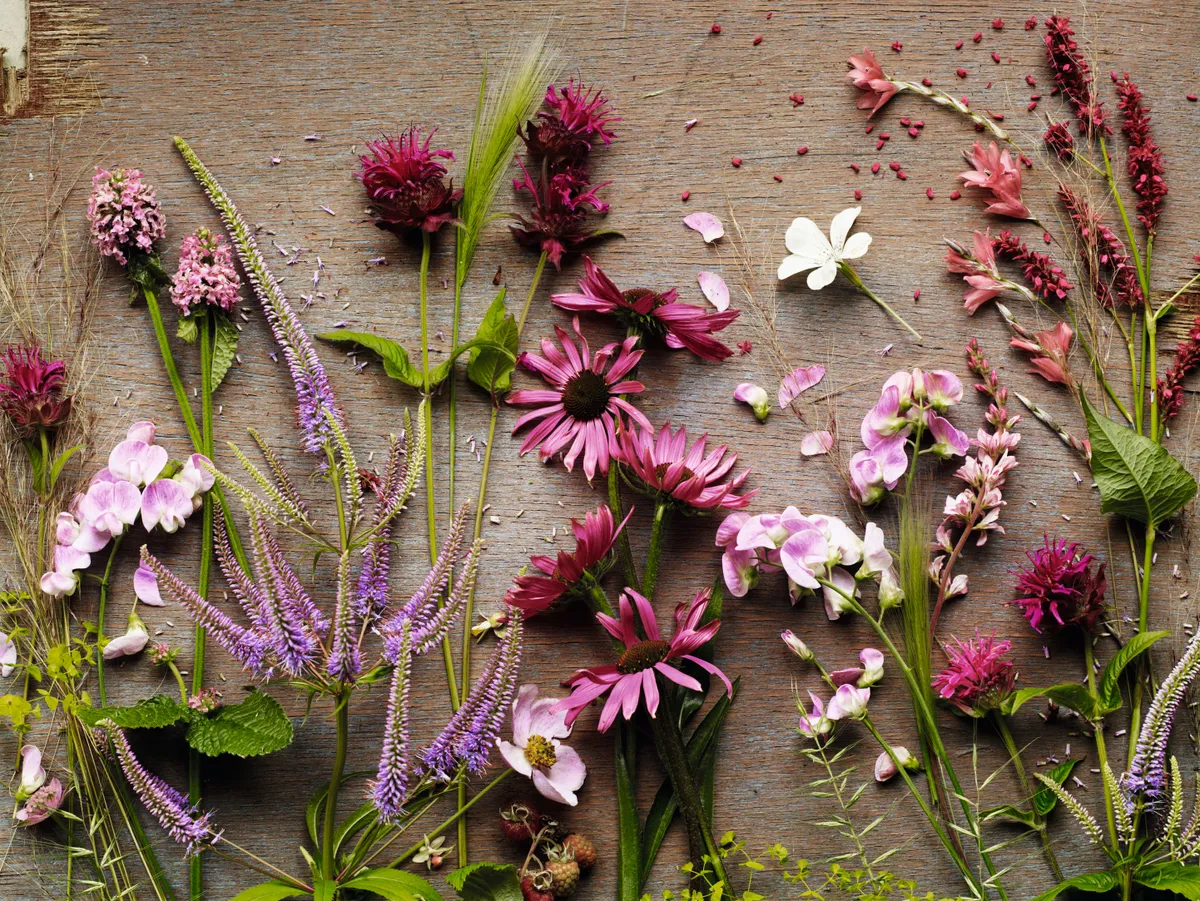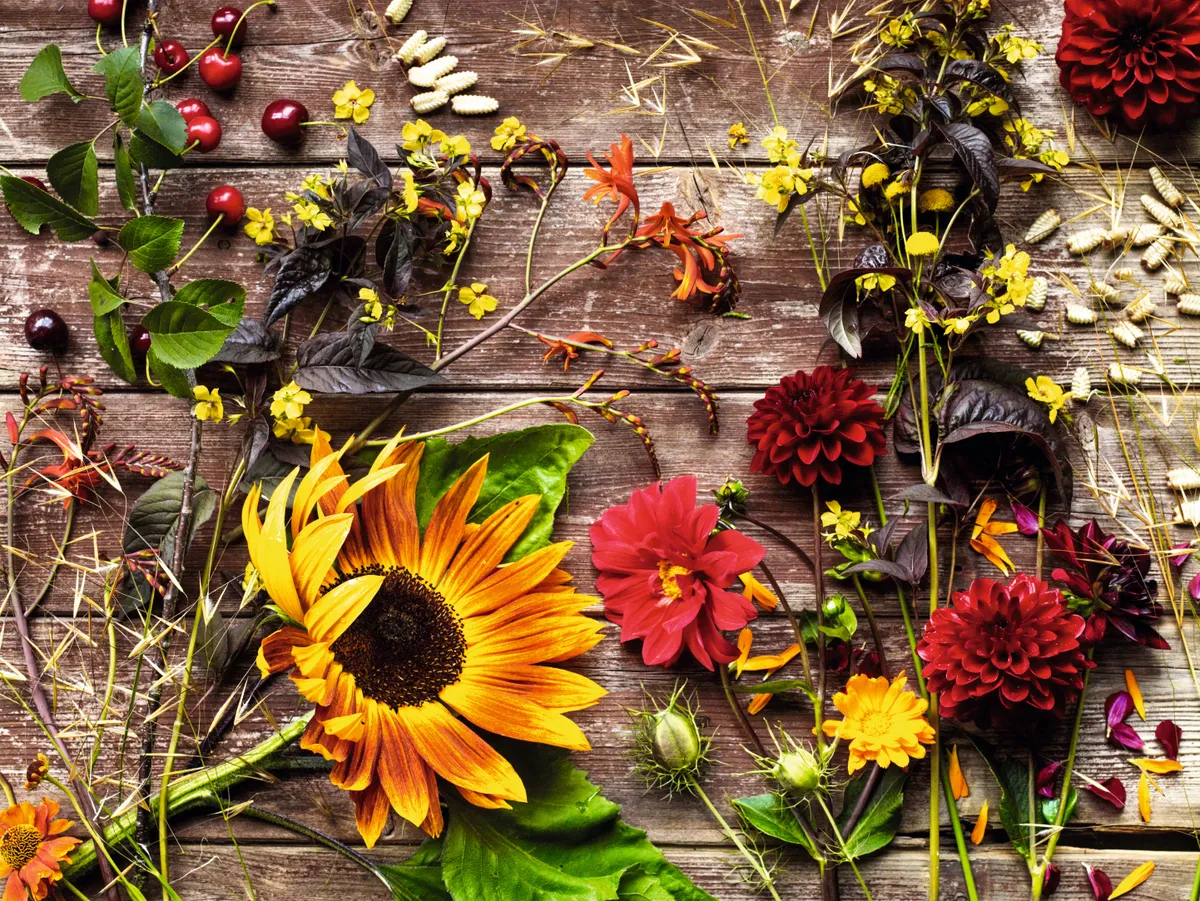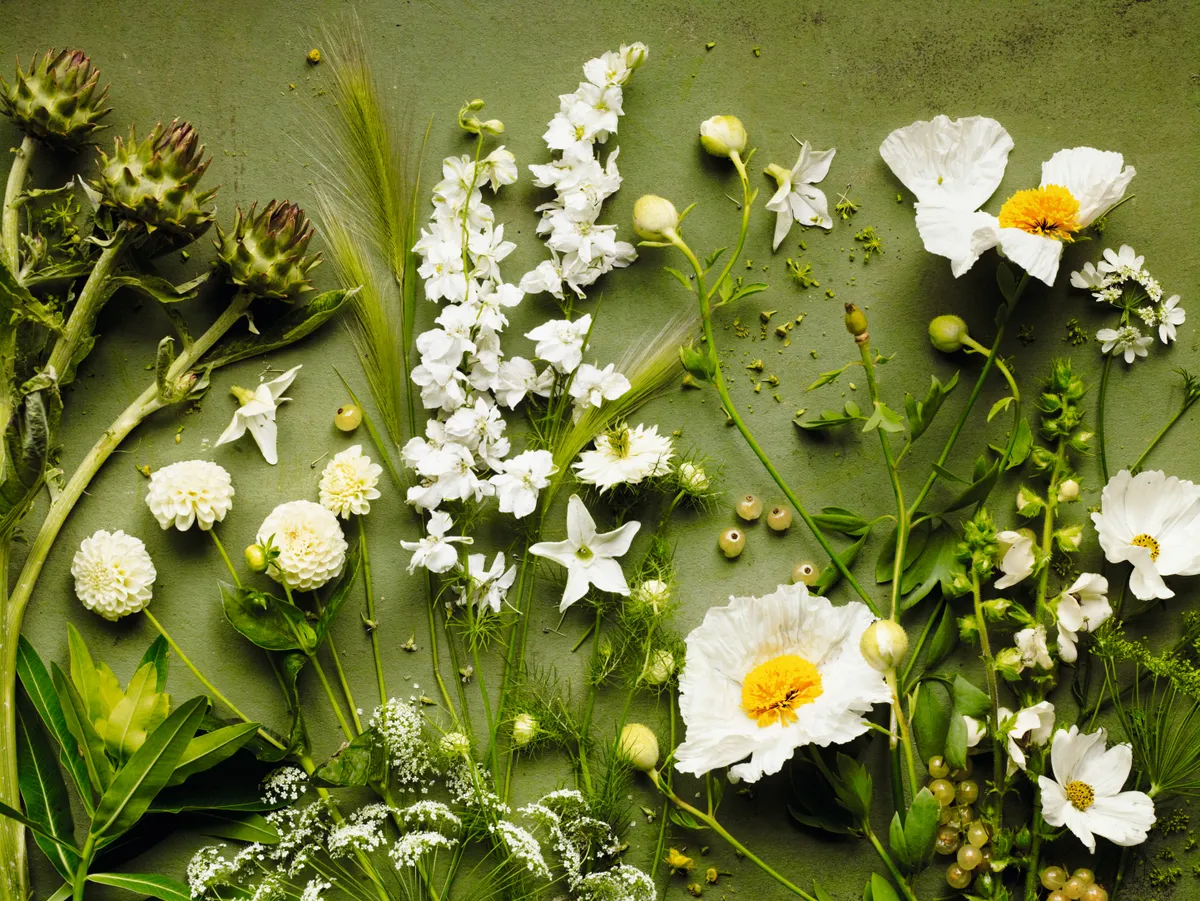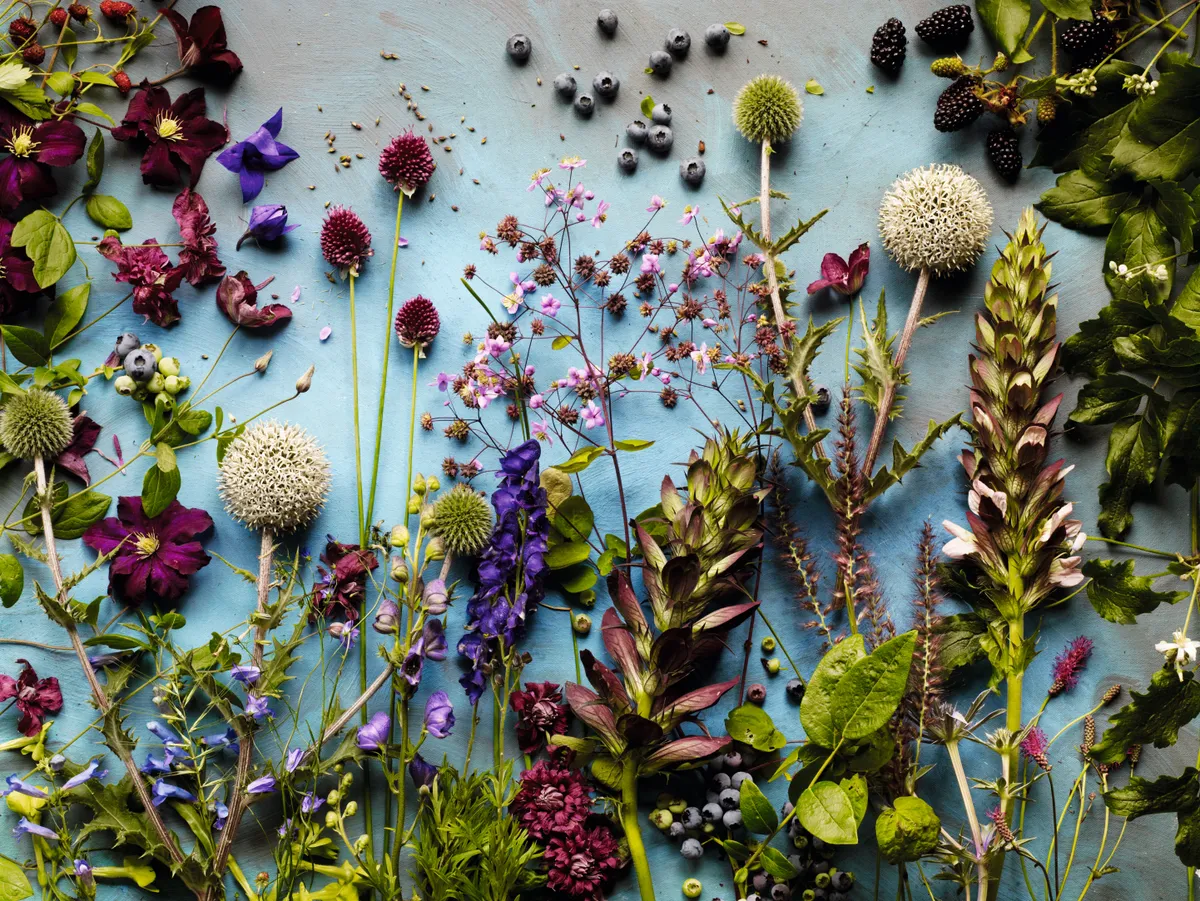The secret of a stunning cut-flower display is all in the mix so we asked florist and plantswoman, Anne Townley to suggest four cut-flower combinations to grow for the ultimate bouquet.
Pink perfection

- Lathyrus latifolius ‘Rosa Perle’ Looks glorious as a massed trailing component in displays. Should stay looking fresh in the vase for around a week. 2m.
- Stachys officinalis Related to lamb’s ears but more useful. Keep cutting the pretty pink flowers to encourage long flowering throughout summer. 50cm.
- Veronicastrum virginicum ‘Fascination’ Easier to grow and quicker to bulk up than other veronicas, but just as useful in the vase. 1.8m.
- Monarda ‘Prärienacht’ Pick the flowers of this bergamot when just opening for longest vase life and keep cutting them from July to late September. 1m.
- Hordeum jubatum Short-lived perennial grass, which adds a lovely texture to bouquets and is also beautiful dried. 70cm.
- Anemone hupehensis Take out the centre flower of each group and pick the flower head when opening. Or wait until the main flower in a group has died when the stem is beginning to dry. 75cm.
- Rubus idaeus On the cusp of ripeness, raspberries add interesting texture to an arrangement. 2.5m.
- Echinacea purpurea ‘Magnus’ Coneflowers and related perennial rudbeckias last well when cut and the seedheads can add impact at season’s end. 1m.
- Euphorbia stricta A wonderful spreading annual with dazzling chartreuse flowers and red stems. Leave all spurges in water overnight before mixing with other flowers to wash out their milky sap. 50cm.
- Agrostemma githago ‘Milas Snow Queen’ This white form of the self-seeding annual looks wonderful viewed close up with its gold-brushed stamens on delicate, black-veined, white flowers. 90cm.
- Dierama igneum Grass-like stems and pretty flowers. Stunning in a vase on its own. 60cm.
- Francoa sonchifolia Easy-to-grow perennial with impressive pink-white spires. The seedheads can add texture to winter arrangements. 90cm.
- Monarda ‘Croftway Pink’ Another excellent, bright-pink, bergamot for arrangements. 80cm.
- Persicaria amplexicaulis Such a useful perennial, providing strong colour and shape in late season. Adds a touch of cheerful wildness to any bunch. 1m.
Golden Glow

- Helenium ‘Sahin’s Early Flowerer’ Bronze, yellow and orange flowers, which bloom for months, especially if you give these perennial plants the Chelsea chop. 1.2m.
- Stipa gigantea This hardy, majestic perennial grass shimmers in the garden in late summer. It is wonderful on its own in a vase or as a companion for bronzes and yellows. 2m. AGM*.
- Crocosmia ‘Lucifer’ Give ‘Lucifer’ room and it will bulk up in a couple of years to a generous clump. Very striking fresh in arrangements and the elegant seedheads are particular favourites. 1.2m
- Prunus cerasus Morello cherries add a decorative extra in flower displays. The cherries last perfectly well out of water for a couple of weeks. 4.5m.
- Helianthus annuus Smaller sunflowers with subtle colours are generally easier to place in a vase than the more traditional, tall, bright-yellow forms. They last for weeks when cut. 1m.
- Lysimachia ciliata ‘Firecracker’ Spreading, ground-covering perennial that is most useful for picking in late spring for its glossy, maroon foliage. Later, the contrast of yellow highlights against the dark foliage is also a winner. 1.2m. AGM.
- Dahlia Possibly the most useful flowers in the late summer garden, there are dahlias for every occasion but multi-petalled forms tend to last longer in the vase than single dahlias. This unknown form grows as a seedling in Anne’s garden. 60cm.
- Nigella damascena seedpods. Green when fresh, turning bronze-red, golden and brown as they age, with horned and rounded forms. 45cm.
- Stipa tenuissima Another useful perennial grass with fluffy, silver-green plumes in late summer that add movement to any bouquet. 60cm.
- Dahlia ‘Karma Naomi’ A cultivar bred for cutting so generally lasts very well in the vase. Many Karma strains have dark stems, all have strong heads. 1m.
- Calendula officinalis A few annual calendulas brighten up any bunch. Yellow forms tend to be more useful than orange, but don’t let too many seed or they can quickly become rampant. 50cm.
- Santolina virens Bright-yellow, button flowers above silvery-green, serrated foliage are perfect for buttonholes and posies. But be careful, as their slightly strange smell is not to everyone’s taste. 60cm.
- Dahlia ‘Arabian Night’ Another excellent dahlia for cutting that is stunning in a large vase on its own or as a focal point in bouquets. Best cut before flowers are fully opened. 1.2m.
- Briza maxima The seedheads are delightful, like nodding insects. This half-hardy annual self-seeds vigorously so take care where you plant it or you’ll be forever trying to remove it. 60cm.
White delight

- Cynara cardunculus This statuesque perennial makes a strong statement at the back of a border and the purplish flowering heads are excellent fresh or dried. Best offset with plenty of foliage. 1.5m. AGM.
- Dahlia ‘Snowflake’ One of the easiest white dahlias to mix with other blooms. Pick when they are just opening as they tend to brown as they age. 80cm.
- Euphorbia cornigera Handsome perennial in flower from May to August with vivid yellow-green flowers and veined white leaves, a brilliant filler. 1m. AGM.
- Ammi majus A justly popular addition to any cutting garden. Grow close together for shorter stems and smaller heads, or space 25cm apart for taller statuesque plants. 1.2m.
- Hordeum jubatum (see Pink Perfection above).
- Delphinium consolida ‘White King’ Pick larkspur as the heads are just opening for longest vase life, the individual spurs are useful in small arrangements and the main stems in large displays. A good alternative to slower bulking delphiniums. 1.2m.
- Nicotiana affinis Perhaps the most striking of the tobacco plant family with generous white heads so useful for large, late-summer displays and divine evening scent in the garden. 1m.
- Nigella damascena ‘Miss Jekyll White’ This white nigella is a sophisticated alternative to more common blues and pinks, and in late summer and autumn the flowers mix well with the seedheads. 60cm. AGM.
- Romneya coulteri As magnificent in the vase as the garden. If picked in bud it lasts for a week in the vase; if picked in full flower the petals drop to leave glorious yellow centres. It can spread extravagantly so best give it space. 2.5m. AGM.
- Ribes rubrum ‘Versailles Blanche’ Trusses are long and strong, and the plant crops heavily so there are always plenty for vases as well as to eat. 1.5m.
- Verbascum creticum ‘Allomnis’ Magnificent stems of white flowers with what looks like an insect in the centre of each flower, cuts for two months from July with plenty of shorter side spires after the main event. Can be tricky to establish but worth persevering. 1.5m.
- Orlaya grandiflora Another popular cutting annual with delicate lacy umbels on branching stems. Orlaya is best direct sown in late summer to establish deep roots, thereafter it should self seed. 50cm.
- Cosmos bipinnatus ‘Sonata White’ (Sonata Series) Another oh-so-useful annual. Most cosmos aren’t worth bothering with but this and C. bipinnatus ‘Purity’ are the best forms for cutting. Easy to sow and grow and useful for months if you keep picking. 45cm.
- Anethum graveolens ‘Mariska’ Umbels start off acid green, then develop into a good yellow and fade to brown. Thoroughly useful in vases at all stages. Annual but a reliable self-seeder. 1.25m.
Purple haze

- Fragaria vesca Wild strawberries add a delightfully unexpected texture to a bouquet. 2m.
- Clematis ‘Warszawska Nike’ Velvety purple flowers on good green foliage. Looks stunning as the trailing component for summer arrangements. 3m. AGM.
- Penstemon heterophyllus ‘Electric Blue’ Easy to grow and place in the vase. One of the most interesting penstemons for cutting. 45cm.
- Platycodon grandiflorus Flowers for longer than many of its campanula relatives, and lasts well in the vase. 20cm. AGM.
- Echinops sphaerocephalus ‘Arctic Glow’ Spiky spheres are stunning in bouquets and vases. Must be picked young or they take on a brown tinge. 1.8m.
- Allium sphaerocephalon To avoid an onion aroma steep them overnight in a pint of water with a teaspoon of liquid Savlon added. 60-90cm.
- Aconitum napellus Tall dark spires are invaluable for their colour and shape. Steep in water separately overnight before putting them with other flowers. 1m.
- Clematis ‘Purpurea Plena Elegans’ Last exceptionally well and the nodding heads are stunning in delicate or large bouquets. 4m.
- Thalictrum uchiyamae Delightfully fine foliage is topped by showers of tiny pink and yellow flowers followed by pretty seedheads. 1.25m.
- Acanthus mollis Stunning huge spires for really large arrangements, but a greedy coloniser of space so don’t grow this unless you can let it roam. 1.5m.
- Vaccinium corymbosum ‘Bluecrop’ Fruits reliably and heavily from midsummer. 2m.
- Pennisetum x advena ‘Rubrum’ Mound-forming grass with brush-like flower. Slightly insignificant in the garden but beautiful in bouquets. 1.5m. AGM.
- Boysenberry Bred from raspberry, blackberry and loganberry, provides interesting texture. 2m.
- Acanthus spinosus Spinosissimus Group Adds similar height to Acanthus mollis. 7.5cm.
- Sanguisorba menziesii All sanguisorbas are good for cutting. The smaller fluffy heads float around a bouquet and larger forms hang down like tails. 75cm.
- Clematis ‘Praecox’ Stems are strong and resilient. Excellent when you want long trails of foliage. 2.5m.
All four arrangements were created by Anne Townley of Ascott Gardens, ascottgardens.co.uk
All of the images in this feature were shot by photographer Andrew Montgomery.
